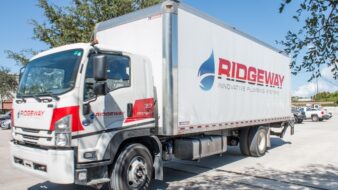The University of South Carolina’s Darla Moore School of Business building has earned LEED Platinum certification, the highest certification awarded by the U.S. Green Building Council (USGBC).
Championed by Darla Moore, for whom the school is named, the building opened in August 2014. It is the first public building in South Carolina to earn LEED Platinum. The Moore School joins business schools at Harvard and Stanford universities among a few U.S. business schools to earn the exceptional rating.
“I’m very proud that the Darla Moore School of Business has earned LEED Platinum certification,” said Moore School Dean Peter Brews. “This places the Moore School among an elite group of buildings earning the highest possible certification for sustainability – a goal that the school set early on in the design and construction of our new building.”
In addition to enhancing the school’s teaching and research activities, the building and its green design has played an important role in the recruitment of students and faculty. Student ambassadors give tours every week that showcase the facility’s many green features.
The USGBC’s LEED (Leadership in Energy and Environmental Design) certification program is the nationally accepted standards for the design, construction and operation of high performance green buildings. There are four LEED certification levels: certified, silver, gold and the highest, platinum.
LEED certification is based on a point system in seven categories that include water efficiency, energy, indoor environmental quality, materials and resources and innovation in design.
The school was selected by the U.S. Department of Energy’s Net-Zero Energy Initiative (Commercial Building Partnership Program), to partner with DOE’s Lawrence Berkeley National Laboratory and other national energy labs to incorporate the latest energy-saving technologies into the building’s design. The U.S. DOE chose to partner with the Moore School for its commitment to incorporate sustainability into its teaching and research and for using its building to make the business case for sustainability.
The Moore School is the third LEED Platinum certified building for the architectural firm Rafael Viñoly Architects.
“We are honored that the Darla Moore School of Business received the highest green building commendation in the United States,” said Viñoly, lead designer and founder of the architectural firm. “It is a gratifying achievement to meet the university’s goals for academic
excellence and a forward-looking vision for partnership with the community, all while setting a benchmark in terms of design and sustainable use of resources.”
The Viñoly team said some the biggest green design challenges were the building’s cantilevered and glass design to maximize natural light and minimize heat gain, the outdoor terrace and roof garden spaces and balancing individual user control with overall building cooling efficiencies in office, classroom and conference spaces.
The building was designed with energy and future use in mind. The green roofs capture storm water for reuse and irrigation, and the building was designed for the potential addition of photovoltaic panels that convert sunlight to energy. Specially designed walls and raised floors allow the school to adapt and reconfigure space to meet future use and needs.
Keith Branham, who served as Stevens & Wilkinson’s chief engineer on the Moore School building, said the project required high-level collaboration and involved many of the university’s engineering graduates who are particularly proud of the hybrid heating, ventilation and air-conditioning (HVAC) systems.
“The building’s hybrid HVAC systems incorporate under-floor air, active chilled beams and variable air volume systems, all designed to reduce the amount of power needed to move air for heating and cooling,” said Branham whose team designed a separate HVAC system for the W.W. Hootie Johnson Performance Hall to ensure quiet air conditioning without affecting the acoustics of the hall. The performance hall serves as a 500-seat lecture hall as well as a performance space for the university’s School of Music. An intensively used space day and night, the hall represents a novel partnership between the business and music schools.
David Dewar, senior project executive with Gilbane Construction, said designing and constructing a building at LEED Platinum standards is “intrinsically complicated” and required a detailed trickle-up approach from crew to management to ensure that procedures and documentation were followed.
Dewar says his favorite green feature is the drinking fountains.
“All drinking fountains in the Moore School include a bottle filler that enables students to fill their reusable water bottles. By using a water bottle, less water is purchased in disposable plastic bottles, which reduces the environmental impact by eliminating plastic products in landfills,” said Dewar who adds the Moore School as the first LEED Platinum building to his many Gold and Silver-level projects.
Led by former dean Hildy Teegen and former university sustainability director Michael Koman, with the involvement of the business community, faculty, staff and students, the Moore School building is the most ambitious green building project in the university’s history.
The university has been a leader in collegiate sustainability for more than a decade. To date, the university has more than 10 LEED certified buildings, of which four – the Honors Residence, the Ernest F. Hollings Special Collections Library, Patterson Residence Hall the Rice Athletics Building – have earned Gold status. Five buildings have earned Silver, and six buildings are pending LEED certification.
The university ushered in an era of building green in 2004 when it opened Green (West) Quad, the state’s first public LEED building and the first green residence hall in the United States. It has been a major driver of South Carolina’s building green success, having played a pivotal role in building the state’s infrastructure for green construction through the training of building professionals, including architects, contractors and engineers, and spurring a green-product market in the Southeast.




Join the conversation: